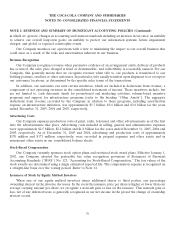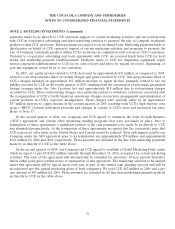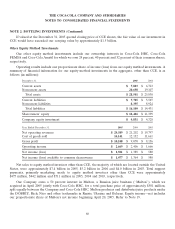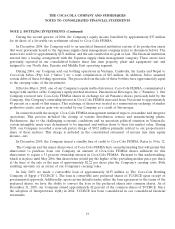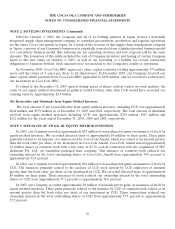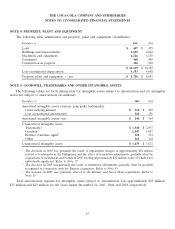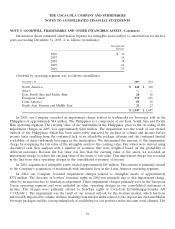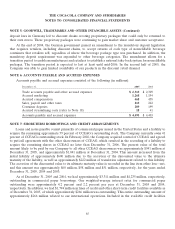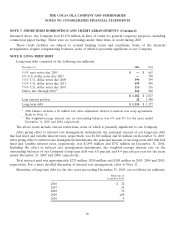Coca Cola 2005 Annual Report Download - page 78
Download and view the complete annual report
Please find page 78 of the 2005 Coca Cola annual report below. You can navigate through the pages in the report by either clicking on the pages listed below, or by using the keyword search tool below to find specific information within the annual report.THE COCA-COLA COMPANY AND SUBSIDIARIES
NOTES TO CONSOLIDATED FINANCIAL STATEMENTS
NOTE 1: BUSINESS AND SUMMARY OF SIGNIFICANT ACCOUNTING POLICIES (Continued)
In 2004, our Company recorded an income tax benefit of approximately $50 million as a result of the
realization of certain tax credits related to certain provisions of the Jobs Creation Act not related to repatriation
provisions. Refer to Note 16.
Effective January 1, 2003, the Company adopted SFAS No. 146, ‘‘Accounting for Costs Associated with Exit
or Disposal Activities.’’ SFAS No. 146 addresses financial accounting and reporting for costs associated with exit
or disposal activities and nullifies Emerging Issues Task Force (‘‘EITF’’) Issue No. 94-3, ‘‘Liability Recognition
for Certain Employee Termination Benefits and Other Costs to Exit an Activity (including Certain Costs
Incurred in a Restructuring).’’ SFAS No. 146 requires that a liability for a cost associated with an exit or disposal
plan be recognized when the liability is incurred. Under SFAS No. 146, an exit or disposal plan exists when the
following criteria are met:
• Management, having the authority to approve the action, commits to a plan of termination.
• The plan identifies the number of employees to be terminated, their job classifications or functions and
their locations, and the expected completion date.
• The plan establishes the terms of the benefit arrangement, including the benefits that employees will
receive upon termination (including but not limited to cash payments), in sufficient detail to enable
employees to determine the type and amount of benefits they will receive if they are involuntarily
terminated.
• Actions required to complete the plan indicate that it is unlikely that significant changes to the plan will
be made or that the plan will be withdrawn.
SFAS No. 146 establishes that fair value is the objective for initial measurement of the liability. In cases
where employees are required to render service beyond a minimum retention period until they are terminated in
order to receive termination benefits, a liability for termination benefits is recognized ratably over the future
service period. Under the previous rule, EITF Issue No. 94-3, a liability for the entire amount of the exit cost was
recognized at the date that the entity met the four criteria described above. Refer to Note 18.
Effective January 1, 2003, our Company adopted the recognition and measurement provisions of FASB
Interpretation No. 45, ‘‘Guarantor’s Accounting and Disclosure Requirements for Guarantees, Including
Indirect Guarantees of Indebtedness of Others’’ (‘‘Interpretation 45’’). This interpretation elaborates on the
disclosures to be made by a guarantor in interim and annual financial statements about the obligations under
certain guarantees. Interpretation 45 also clarifies that a guarantor is required to recognize, at the inception of a
guarantee, a liability for the fair value of the obligation undertaken in issuing the guarantee. The initial
recognition and initial measurement provisions of this interpretation were applicable on a prospective basis to
guarantees issued or modified after December 31, 2002. We do not currently provide significant guarantees on a
routine basis. As a result, this interpretation has not had a material impact on our consolidated financial
statements.
76






